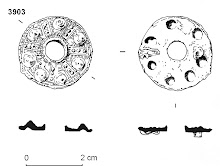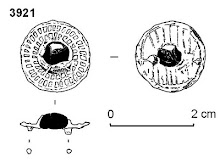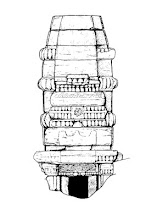The rest of TAG was the usual mix of sessions on theory, research and practice (although it didn’t seem very ‘TAGy’ this year, no sessions on post-processualism in Star Trek…) and catching up with old friends, and meeting new ones. Highlights for me included an excellent keynote speech critiquing reflexive archaeology and multivocality at Çatalhöyük by Shahina Farid, a paper on oral history and industrial period archaeology by Kerry Massheder, Anglo-Saxon cremation pots as brewing vessels by Gareth Perry, Viking Age archaeology by James Barratt, salt-making on the Atlantic coast and the EcoSal Project by Andrew Fielding, and Michael Nevill on Industrial Archaeology, databases and Grounded Theory. I’m looking forward to next year’s conference at Bournemouth.
TAG 2012 Liverpool
I’m just back from three days at TAG in
Liverpool. I presented a short paper on simple, affordable and effective
training methods for site staff as part of the Diggers' Forum session,
the paper will be published in full next year and the DF is planning on
publishing all the papers from their session in some format. An earlier
version of my presentation is available on the FAME website: http://www.famearchaeology.co.uk/2012/07/presentations-from-fit-for-purpose/#more-618
The rest of TAG was the usual mix of sessions on theory, research and practice (although it didn’t seem very ‘TAGy’ this year, no sessions on post-processualism in Star Trek…) and catching up with old friends, and meeting new ones. Highlights for me included an excellent keynote speech critiquing reflexive archaeology and multivocality at Çatalhöyük by Shahina Farid, a paper on oral history and industrial period archaeology by Kerry Massheder, Anglo-Saxon cremation pots as brewing vessels by Gareth Perry, Viking Age archaeology by James Barratt, salt-making on the Atlantic coast and the EcoSal Project by Andrew Fielding, and Michael Nevill on Industrial Archaeology, databases and Grounded Theory. I’m looking forward to next year’s conference at Bournemouth.
The rest of TAG was the usual mix of sessions on theory, research and practice (although it didn’t seem very ‘TAGy’ this year, no sessions on post-processualism in Star Trek…) and catching up with old friends, and meeting new ones. Highlights for me included an excellent keynote speech critiquing reflexive archaeology and multivocality at Çatalhöyük by Shahina Farid, a paper on oral history and industrial period archaeology by Kerry Massheder, Anglo-Saxon cremation pots as brewing vessels by Gareth Perry, Viking Age archaeology by James Barratt, salt-making on the Atlantic coast and the EcoSal Project by Andrew Fielding, and Michael Nevill on Industrial Archaeology, databases and Grounded Theory. I’m looking forward to next year’s conference at Bournemouth.
Sections, shoring and single context recording
A
recent contract with LP Archaeology in the City of London raised some aspects
of recording worth some thought. The contract was an archaeological evaluation
on a site that straddled the projected line of the Roman, medieval and
post-medieval ditches that lie immediately outside the walls of Londinium and
London. Due to the expected depth of the archaeological deposits (geo-technical
boreholes showed up to 7.8m of potentially archaeological strata) the
evaluation strategy was for five 2.5m x 2.5m test pits that would be dug as
fully shored shafts. The test pits were located to give information on the
survival of archaeological strata, the nature of any such deposits, and the
potential survival of complex masonry and environmentally significant remains.
The pits were positioned across the site in an L-shape with three of the test
pits located to provide an east–west transect across the expected line of the
defensive ditches.
In
order to illustrate the excavated sequence it was decided to record a
representative section of each test pit, these could be used to construct an
illustrated section across the site which would illustrate the strata found in
the test pits, along with their conjectured extent. The impact of the proposed
development could be mapped against this to give an immediate visual
representation of the site. Unfortunately given the projected depth of the test
pits they would need to be close-shored with steel trench sheets and
timberwork. After the first metre or so of each pit had been dug and the shoring
had gone in, there would be little opportunity to view and record a traditional
section as due to the loose nature of the fill the trench sheets needed to be
dropped every 200-300mm to ensure the integrity of the shoring*.
 |
View of Test Pit 3 at approximately 7m depth
|
Electronic site registers: a way forward?
For many years context sheets and registers have been written on paper, whilst the databases containing the context information have been held on computer. Many early context sheets were designed for computer entry, and the standardised format, definitions and controlled vocabulary of a processual recording system lends itself perfectly to computer entry. The level of actual computer entry of context data varies massively across the country, with some units inputting all context data, whilst others select certain key details, and most of this data entry takes place off-site and in post-ex.
Minories
Work at the Minories evaluation is now completed, the test pits
have all been backfilled and work on the report is well under way. The evaluation has
given LP Archaeology an excellent insight into the type of deposits on the
site, the range of artefacts, and the environmental conditions. Just as
importantly we now have a better idea of the existing building’s foundations,
and how they have affected archaeological survival, and how they will govern
the excavation methodology.
Natural gravels visible in a sondage through the lowest, organic rich, ditch fills
London Finds Factsheets
Urban Archaeology is planning a new series of illustrated factsheets
on common London artefacts and has submitted an application for a grant to cover
the cost of research, writing and production.
The factsheets will be illustrated ‘spotter’s guides’ to
each class of find, with a brief text on the artefact class, illustrated
examples, common identification features, date ranges, and further reading. The
information will be pitched at a level suitable for both professional Diggers
and the interested amateur archaeologist or student. The factsheets will be
published online as free pdf downloads and will be available as A2 posters and as A4 factsheets. Work on the initial
series of factsheets will be completed next year, with planned factsheets
including London clay tobacco pipes, medieval and post-medieval pottery, and
ceramic building material.
Urban Archaeology believes that these factsheets will help
archaeologists in the basic identification of artefacts, will expand their
knowledge of those finds, and will hopefully encourage further interest in
finds and their study. The factsheets will hopefully prove invaluable to a wide
range of archaeologists, from Diggers wanting to know more about the artefacts
they are digging up, to members of the public eager to identify finds seen on
the Thames Foreshore. The publication of the factsheets on the web will mean
that they can be accessed at the point of need, via a smartphone or computer,
as well as printed out for display in site huts, processing areas, for use as
training and educational material, and for individual use. Urban Archaeology
plans to expand the series over the coming years and hopes to develop
factsheets on a broad range of archaeological subjects.
The City ditch
At the close
of the week we were still excavating late 16th century
deposits within the test-pit sited over the City ditch; the adjacent borehole
records further deposits beneath these which should date to the disuse of the
ditch in the late medieval/Tudor period. John Stow records in the Survey of
London that the entire City ditch was ‘cleansed’ in 1477, and that parts of the
wall were repaired in brick at the same time. Sections of those brickwork
repairs, including ‘diaper’ patterned decorative work, are still visible at St
Alphege on London Wall.
Mapping, dumping and dating at Minories
Evaluation
work is continuing at Minories. So far the archaeological sequence is broadly
as predicted in LP Archaeology's desk based assessment, and we are now down to
mid 17th century levels in one trench, digging through levelling dumps containing lots of brick rubble.
The upper
surface of these dumps had been levelled out to form an external surface in the mid-late 17th century, with
a brick pier base suggesting a building that is not shown on Ogilby and Morgan's map of 1676. Ogilby and Morgan's mapping is known to be highly
accurate and is an excellent snapshot of the built environment in the late 17th
century, however the surveyors could not always access back yards and enclosed private
land, and the speed of building after the Great Fire means that some buildings
are missing -especially smaller or more temporary structures. The map is
however by far the best City-wide survey of London before the Ordnance Survey, and is
a fantastic resource for archaeologists and historians with accurate mapping of roads, yards and houses, as well as the contemporary street and place names.
There are tantalising glimpses of industrial
activity within the rubble dumps including glass making waste, crucible
fragments and slag, as well as Roman brick and opus signinum (which may or may not be from the adjacent Roman town
wall). Closely dateable clay tobacco pipes and ceramics should allow the
sequence of dumps and surfaces to be dated and the rate of the dumping worked
out -is this a single, orchestrated, episode of ground levelling intended to eradicate the
line of the former City Ditch, or a piece-meal and ongoing process? Deep excavation in the City of London
For the next few weeks Urban Archaeology will be supporting
LP Archaeology on an evaluation in the City of London. The site is on Minories,
north of the Tower of London, and is situated immediately east of the City wall over the line of the Roman and
medieval city ditch, and the land immediately to the east –possibly including
areas used as a cemetery in the early Roman period.
 |
| The view from the Minories site, Tower Bridge, Tower of London and the medieval City wall. |
FAME Forum and Diggers' Forum/Prospect conferences
Last weekend Chiz spoke at two conferences in as many days: the FAME Forum which was themed on skills and employability, and the Diggers' Forum/Prospect conference on careers, both in York. Chiz gave an updated version of the training and reskilling paper he presented at Winchester at both sessions, as well as a short presentation on the Diggers' Forum survey on away work and travel.
21st Century Archaeologists
Chiz Harward presented a paper on training and reskilling at the recent 21st Century Archaeologists day-conference at the University of Winchester on the 19th June. His paper continues the themes set out in Chiz's recent article in The Archaeologist, and sets out the need to put training at the heart of everything we do on site. Chiz argues that there is a need for clear and logical methodologies on site in order to provide an adaptive framework within which we can excavate and record. These methodologies also need to be integrated with Post-excavation procedures and the boundaries between site and post-ex, and supervisor and archaeologist roles need to be blurred.
Training must be given space in which to be provided, but we also must give staff the time to do their job properly. It is no good training staff in stratigraphic excavation techniques if they are ordered to 'just hack it out' when they return to site.
Training must be given space in which to be provided, but we also must give staff the time to do their job properly. It is no good training staff in stratigraphic excavation techniques if they are ordered to 'just hack it out' when they return to site.
Short-notice, short-term site cover on the Isle of Wight
Urban Archaeology has just finished providing watching brief cover for a national archaeological contractor and IfA Registered Organisation. Work involved the monitoring of construction works on a major housing development on the Isle of Wight. The experience of many years working on construction sites means that following a client briefing Chiz Harward can be trusted to 'read' the situation on site quickly, and to respond effectively with minimal need for the client to manage the situation.
Urban Archaeology can mobilise quickly and can be relied upon to provide flexible and professional cover on the full range of archaeological fieldwork projects from watching briefs to full excavation. The ability to engage a highly experienced archaeologist, who can be trusted to make the right decisions on site, is a major advantage to any archaeological employer. Urban Archaeology's services are of benefit to any archaeological organisation that finds themselves short-staffed, or in need of specialist site knowledge, such as for urban excavations.
Urban Archaeology can mobilise quickly and can be relied upon to provide flexible and professional cover on the full range of archaeological fieldwork projects from watching briefs to full excavation. The ability to engage a highly experienced archaeologist, who can be trusted to make the right decisions on site, is a major advantage to any archaeological employer. Urban Archaeology's services are of benefit to any archaeological organisation that finds themselves short-staffed, or in need of specialist site knowledge, such as for urban excavations.
Thames Discovery Programme Foreshore Factsheets
Looking through my past projects I came across the factsheets I prepared for the fantastic Thames Discovery Programme. The brief was to prepare a series of double-sided A4 factsheets presenting information on a range of common structures found on the Thames foreshore: causeways, fishtraps, gridirions and bargebeds, jetties and wharves and vessels. The finished factsheets were designed to be downloaded and printed out for use on the foreshore by the FROGS and can be viewed at http://www.thamesdiscovery.org/discover/foreshore-factsheets-vessels.
Upcoming training papers
I'll be presenting a new paper on training archaeologists at the upcoming 21st Century Archaeologists conference in Winchester on the 19th June. I'll also be talking on training at the FAME Forum in York on the 13th July, and on both the Diggers' Forum Away Work and Travel Survey, and training for archaeologists, at the Diggers' Forum/Prospect conference in York the next day .
Subscribe to:
Posts (Atom)














